Cacti are becoming more and more popular among plant lovers and people who like to decorate their homes because they have interesting shapes and don’t need much care. Growing cactus in flower pots has many benefits, whether you’re an experienced gardener or a beginner looking for easy-to-take-care-of pets. Cacti in pots can do well both inside and outside. They add a touch of greenery and an interesting design feature to any room.
This complete guide will talk about the many benefits of growing cacti in pots, how to choose the right species and pots, how to take care of them, common problems, and creative ways to use cacti in your garden or home decor.
Introduction: Why Cactus in Flower Pot Are So Popular
Cacti are beautiful because they are simple and can grow well with little care. There are many ways to bring nature inside, and growing cacti are great for people who are busy or live in cities with limited outdoor space. Their unique shapes, which include round barrel cacti and tall columnar types, make displays in homes and businesses that stand out.
Cacti are also very flexible and can do well in pots of any size, which makes them great for small spaces like flats, windowsills, and patios. They also do well with modern lives because they don’t need to be watered very often and can handle a variety of conditions inside.
This piece will teach you everything you need to know to grow and take care of a cactus in flower pot. It will cover picking the right cactus, picking the right pot, planting, caring for the plant, fixing common problems, and fun ways to decorate your home with cacti.
Benefits of Growing Cactus in Flower Pots
There are many useful and attractive reasons to grow cactus in flower pot. Here are a few of the most important pros:
1. Low Maintenance
You can grow cacti even if you don’t have time to water them often or are new to gardening because they can handle being dry. They can go for a long time without being watered because their roots store water. Most of the time, you only need to water your cactus once every two weeks. This makes it a great choice for busy people or people who want a low-maintenance plant.

2. Space-Saving
Cacti in pots look great in small places like apartments, offices, and balconies. Cacti can grow in small spaces and pots, unlike bigger plants that need a lot of room to grow. A cactus in a pot can do well even in small places like on a desk or on a shelf. For added convenience, you can move cacti around your home or garden whenever you need to.
3. Decorative Appeal
Cacti are very eye-catching plants that can make any place more interesting to look at. Cacti are great for making a statement in your home decor because they come in many different colors, shapes, and textures. No matter what kind of cactus you choose—a round barrel cactus, a tall columnar type, or one with bright flowers—it will stand out.
If you like to decorate with plants, cacti are a unique and useful choice. They can be used in modern, rustic, minimalist, or eclectic rooms to add color and plants without taking over the style.
4. Air Purification
It’s not well known, but cacti and other houseplants can help clean the air. They take in carbon dioxide and give off oxygen, which makes the air in your home better. Cacti can also help get rid of formaldehyde, benzene, and other dangerous toxins that are indoors. This makes them a beautiful and useful addition to your home.
5. Versatility
There are many types of pots that can be used to grow cacti, from small flower pots to bigger decorative planters. They can be put up in any room of the house, from the kitchen to the bedroom, because of this. Cactus in flower pot give you the freedom to make an arrangement that fits your room and style, whether you want to make a small indoor garden or a beautiful outdoor display.
Choosing the Right Cactus for a Flower Pot
1. Echinocactus (Barrel Cactus)
For small to medium-sized pots, the Echinocactus, which is also called the barrel cactus, is a great choice. It’s easy to spot because it’s round and has sharp edges. The barrel cactus grows slowly, so it won’t quickly outgrow its pot. It does best in bright light and doesn’t need much water, which makes it great for newbies.
2. Opuntia (Prickly Pear Cactus)
The Opuntia, which is also called the prickly pear cactus, does best in bigger pots. As long as it has enough room, its pads can get pretty big, giving it a unique look. Both indoors and outdoors are fine for the prickly pear cactus, but it needs a lot of sunshine. It’s also a good choice for people who want a cactus with flowers they can eat.
3. Mammillaria (Pincushion Cactus)
The Mammillaria, also known as the pincushion cactus, is a small, round cactus that does well in small pots or inside. It has thick spines and is known for having small, bright flowers. These plants do well in both direct sunlight and bright, indirect light. They are also easy to take care of.
4. Haworthia
Haworthia is a small plant that does well indoors and doesn’t need much care. It grows well in small pots, which is why many people choose it for work plants or flower arrangements. Haworthia doesn’t need as much sun as some other cacti, so it does best in places with indirect light. It’s beautiful rosette-shaped leaves make any room look better.
5. Astrophytum
The star cactus and other astrobium cacti are known for having unique forms and markings. They do well in small pots and don’t need much care, so they’re a good choice for rooms with lots of light inside. On occasion, these cacti also have lovely yellow flowers.
When choosing a cactus, consider the following factors:
- Size of the pot: Pick a type of plant that won’t quickly grow too big for its pot.
- Sunlight: Make sure the type of cactus you pick will do well in the light you have. Most species do best in bright straight light, but some can handle indirect light.
- Indoor vs. Outdoor: When choosing a cactus to grow outside, make sure it can handle changes in temperature and the possibility of getting wet.
Selecting the Right Flower Pot for Cacti
Picking the right pot for your cactus is very important for its health and life. The pot you choose should let water drain properly, fit the plant well, and match the style of your home.
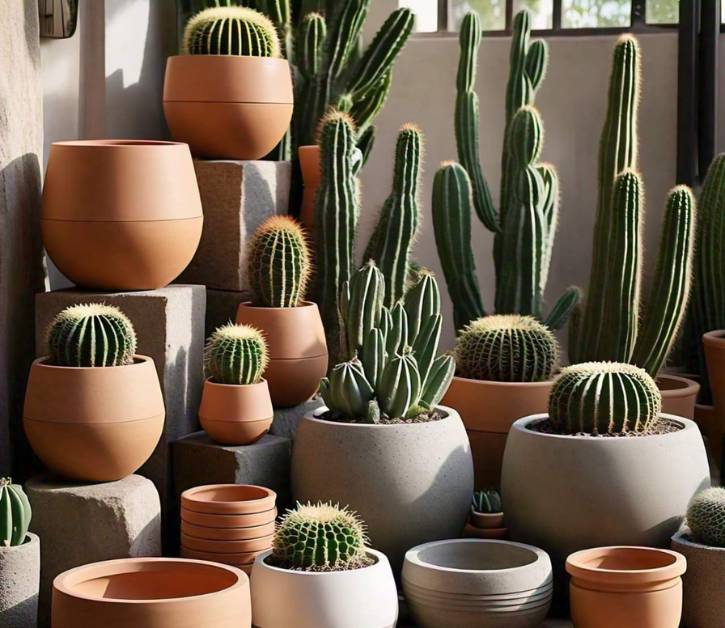
1. Material
What the pot is made of can have a big effect on your cactus’s health. These are the most popular things used to make pots:
- Terracotta: For plants, terracotta pots are a great choice. Because they are porous, air can flow through the walls of the pot. This keeps the soil from getting too wet. This is very important for cacti because their roots will rot if they stay in wet dirt for too long.
- Ceramic: Just like clay pots, ceramic pots let air flow well and come in many styles. Make sure the pot has holes in the bottom so that water doesn’t build up.
- Plastic: Plastic pots are cheap, light, and easy to carry, but they keep water in, which can cause plants to get too much water. If you choose a plastic pot, be extra careful not to overwater it and make sure it drains well.
- Concrete: Because they are heavy, concrete pots keep plants warm when they are outside. They might be too heavy to use inside, but they work well for bigger plants.
2. Drainage
Your potted plant needs to be able to drain well for it to stay healthy. Pick a pot that has holes in the bottom to let water drain. With these holes, extra water can get out, so it doesn’t pool at the bottom of the pot and kill the roots. If you like a beautiful pot that doesn’t have holes for drainage, you could use it as a cover for a smaller pot that does have holes for drainage.
3. Size
Cactus in flower pot plants like it when their roots are a little crowded, so they don’t need a pot that is too big. Pick a pot that is just a little bigger than the cactus. Too much water can build up in a pot that is too big, which can cause root rot. A smaller pot also keeps the cactus from spreading out too much and helps it keep its small shape.
4. Aesthetic Considerations
The pot you choose can complement the cactus and your overall decor. For example:
- Haworthia is a simple cactus that looks good with sleek, modern pots.
- Rustic terracotta pots are an excellent choice for displaying a barrel cactus.
- In a big, fancy clay pot, a tall columnar cactus can make a strong statement.
To make the pot look like it belongs in your home, try to match its color, shape, and style.
How to Pot a Cactus: A Step-by-Step Guide
Because of its spines, potting a cactus might look scary, but it’s actually very easy if you know what you’re doing. Here are the right and safe steps to pot your cactus:
1. Prepare the Pot
First, you should prepare the container by placing a layer of gravel or small stones on the bottom of the container before you plant your cactus. It keeps water from pooling at the bottom of the pot and helps the soil drain better.
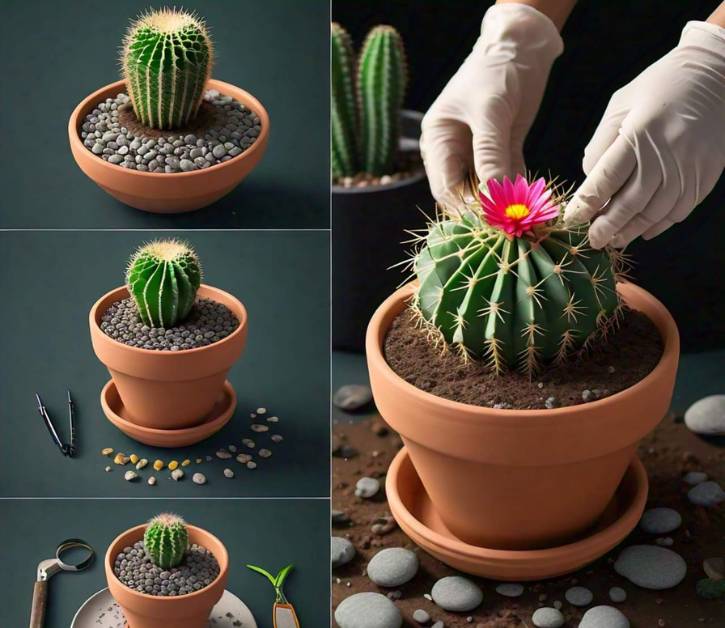
2. Use Cactus Soil
Cacti need soil that drains quickly, and regular potting mix can keep too much water in, which can cause root rot. cactus or plant potting mix is the best choice because it is made to let water drain quickly. If you do not have access to cactus soil, you can make your own mix by combining standard potting soil with sand, perlite, or small gravel. This will allow you to construct your own cactus soil. With this mixture, you can rest assured that any extra moisture will be drained away from the roots.
3. Handle the Cactus Safely
Cacti can have sharp spines, so be very careful when you handle them to avoid hurting yourself. If you don’t want to touch the spines, hold the cactus with kitchen tongs, thick gardening gloves, or newspaper. If you are using newspaper, fold it several times and wrap it around the cactus to protect your hands from its sharp points.
4. Pot the Cactus
Carefully place the cactus in the middle of the pot, making sure it sits at the same level as it did in the old pot. Fill in around the roots with the prepared cactus soil and lightly press down to hold the plant in place. Be careful not to pack the earth too tightly, as this can stop water from draining and air from getting to the roots.
Put small rocks or pebbles around the base of the cactus to help it stay stable if it is bending or not standing straight.
5. Watering After Potting
It’s important not to water the cactus right away after putting it in a pot. Allow the plant to get used to its new spot for a few days so that any roots that were hurt can heal. Root rot is more likely to happen if you water too soon after repotting. After a few days, give the cactus a little water. Make sure the soil dries out totally between waterings.
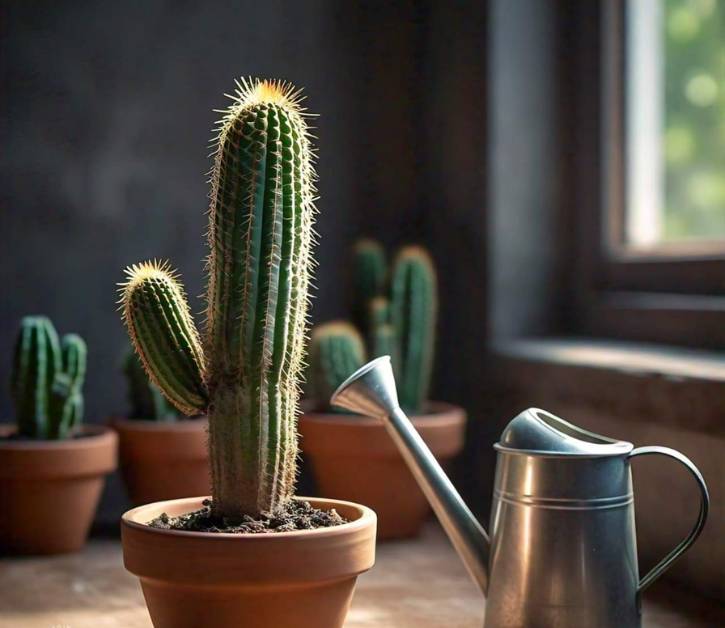
Caring for Cactus in Flower Pots
Although cacti are very hardy plants, they do need special care to do well in flower pots. To keep your cacti healthy and looking their best, here are some important things you should know about taking care of them.
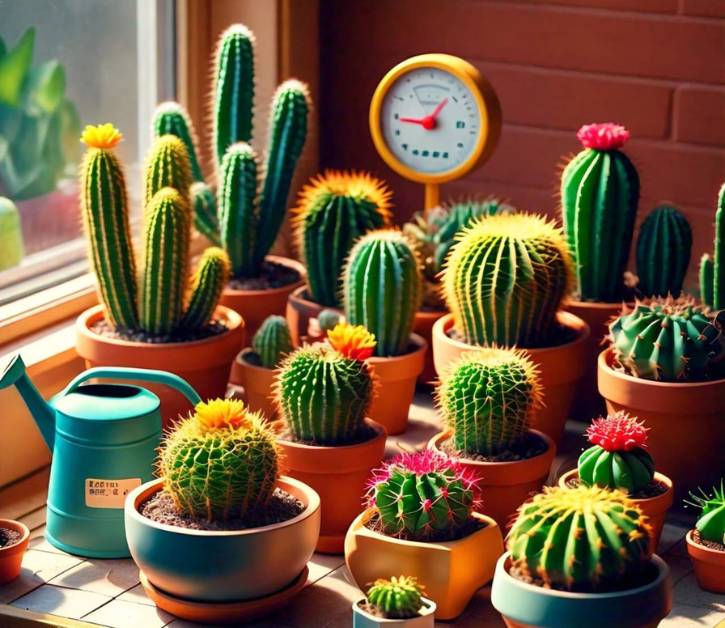
1. Watering
New cactus owners often make the mistake of giving their plants too much water. Cacti are native to dry places and have evolved to be able to live with very little water. Most of the time, it’s better to keep a cactus below water than above it.
- Frequency: Deeply water but not too often. Every 2 to 4 weeks, depending on the weather, give your potted plant water. During the growing season (spring and summer), you may need to water more often. During the dormant season (fall and winter), you should only water once a month or less.
- Watering Method: Give the plant water until the extra runs off the bottom of the pot. Make sure the soil is completely dry before you water it again. Root rot can happen if you leave the pot in water for a long time.
2. Sunlight Requirements
It is best for cacti to get bright, indirect sunlight. Most types like it when they are in the sun, like on a windowsill or in a bright area of your home. And for plants indoor:
- Ideal Placement: Put them near a window that faces south to get the most sunlight. If the cactus turns yellow or brown because of too much direct sunlight, move it to a spot where it gets bright, indirect light.
- Outdoor Cacti: It is best to place outdoor pots in a sunny location, such as on a balcony or patio. It is important to make sure that the cactus is protected from excessive rain and other severe weather conditions.
3. Temperature and Humidity
Cactus in flower pots like it when it’s warm and dry, which makes them great for living indoor. It is best for most cacti to be kept between 65°F to 85°F (18°C to 29°C). They can survive in cold temperatures, but being in temperatures below 50°F (10°C) for a long time can hurt the plant.
Humidity: Cacti are able to survive in dry places. Cacti do well in dry air, like that found inside during the winter. Do not put your cactus in places that are too humid, like bathrooms, because the humidity can cause fungal diseases or rot.
4. Fertilization
When compared to other houseplants, cacti that are grown in flower pots have relatively minimal nutritional needs; however, they can benefit from occasional feedings throughout their growing season, which occurs during the spring and summer months. Once every 4 to 6 weeks, apply a cactus-specific fertilizer or a diluted, balanced houseplant fertilizer to the environment.
Avoid Over-fertilizing: Cacti don’t need a lot of fertilizer, so don’t give them too much. If you do, the plant could get sick or grow too tall. Always follow the advice on the fertilizer package, and if you need to, dilute it more than what is suggested.
5. Repotting Cacti
Cactus in flower pot plants grow slowly and like to have a little root boundness, but they will need to be repotted when they get too big for their pots. Usually, plants need to be repotted every two to three years, but this can change based on their size and growth rate.
- Signs It’s Time to Repot: The plant may need a bigger pot if its roots are sticking out of the drainage holes or if it looks like it has stopped growing. Be careful with the spines and follow the same steps as when you pot up a new cactus.
- Pot Size: If you want to avoid overwatering your plant, choose a pot that is one size larger than the one you are currently using. However, you should avoid going too large.
Common Problems and Solutions for Potted Cacti
Most cactus in flower pot are hardy plants, but they can have some problems when they’re grown in pots. You can fix these problems by following these steps:
1. Overwatering
Most of the time, cactus in flower pot problems are caused by too much water, which can cause root rot. Some signs of too much watering are:
- Branches that are turning yellow or are soft and mushy
- Bad smell coming from the ground
- A cactus that is wilting even though the soil is wet
Solution: Reduce the number of times that the cactus is watered, make sure that the pot has adequate drainage, and think about repotting it in cactus soil that is both fresh and dry. If the root rot is bad enough, you might have to cut off the sick parts of the plant and let the healthy parts dry out before putting them again.
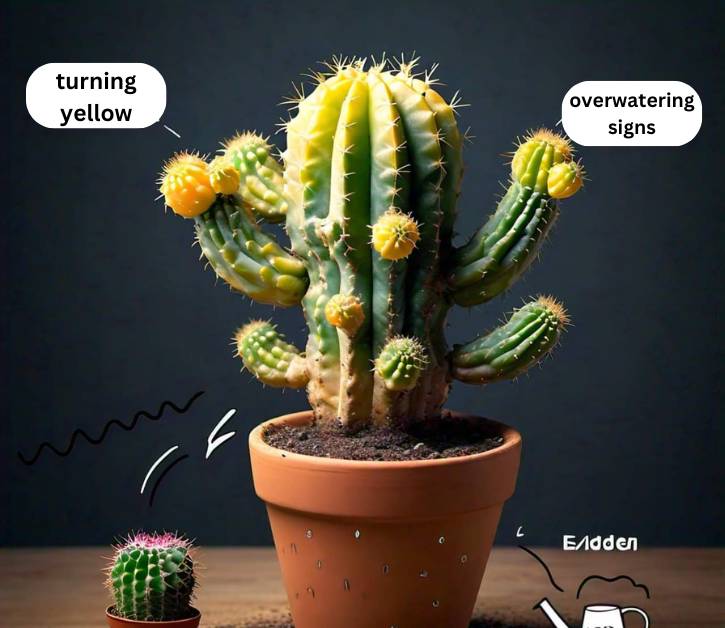
2. Lack of Sunlight
In the event that your cactus begins to stretch, become leggy, or lean to one side, it is possible that it is not receiving sufficient light. Cactus in flower pot that don’t get enough sunlight will often get weaker and longer as they try to get more light.
Solution: You should move the cactus to a brighter spot where it can get more direct sunshine. If natural light isn’t enough, you might want to use a grow light to give the plants the light they need.
3. Pest Issues
Cactus in flower pot plants are usually not bothered by pests, but mealybugs, spider mites, and scale insects may sometimes come to them. Mealybugs look like white cotton balls grouped together, and spider mites make tiny webs on plants.
Solution: A cotton swab soaked in neem oil, insecticidal soap, or rubbing alcohol can be used to get rid of pests. Keep the infected cactus away from other plants to stop the infection from spreading.
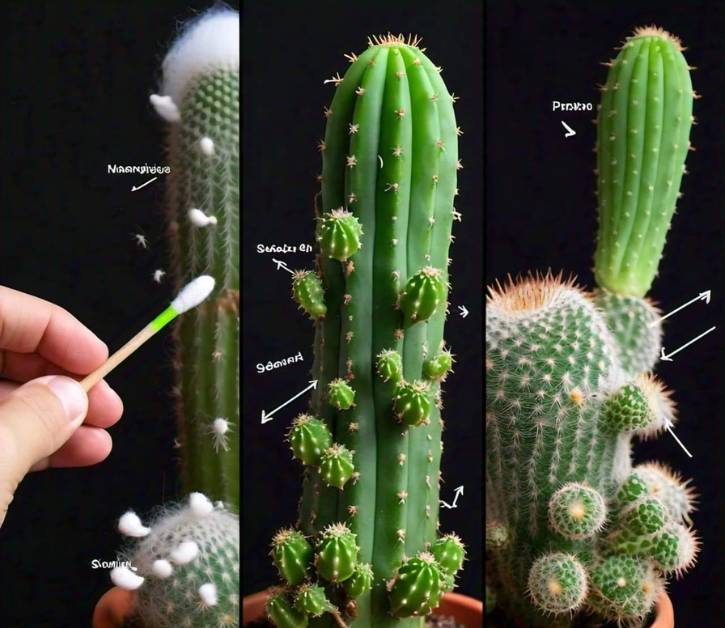
4. Sunburn
Cactus in flower pot that are quickly put in direct sunlight can get sunburned, especially if they have been inside. This makes spots on the cactus’s skin that are white or brown.
solution: Slowly get the cactus used to more light over time. Move it to a spot with some shade, and then slowly bring it into full sunlight over a few weeks.
Decorating with Potted Cacti
Not only are cacti easy to take care of, they also make interesting and useful home decor. You can use cactus in flower pot in your home and garden design in these creative ways:
1. Indoor Displays
Cacti in pots can be put on shelves, windowsills, or side tables. Putting together cacti of different sizes can make a striking layout, or you can keep one big cactus as the room’s hub.
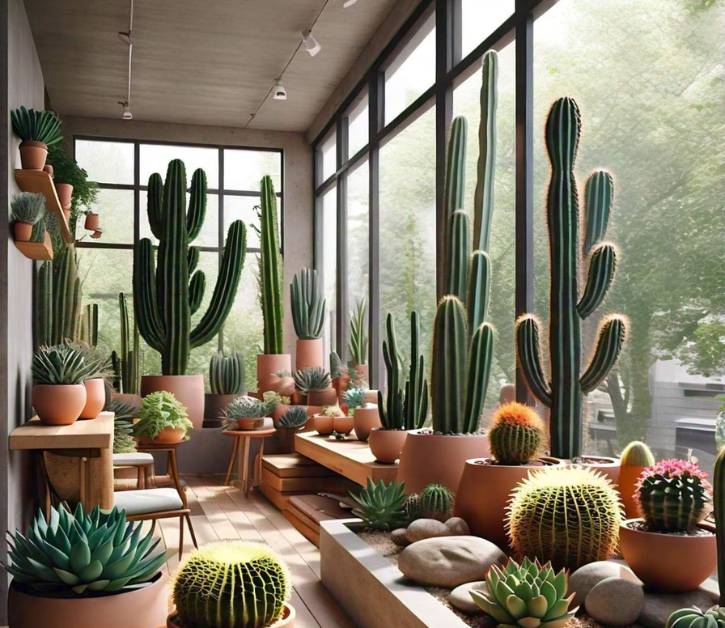
2. Outdoor Arrangements
When you put cactus in flower pot on your patio, balcony, or garden, it can make the area look nicer and require less care. Try these things:
- Container Gardens: In big pots or planters, group cacti and other succulents together to make a colorful, drought-resistant garden.
- Patio Decor: As focal points in outdoor sitting areas, put bigger cacti in ceramic or concrete pots. If you want a natural, modern look, pair them with stone or wood.
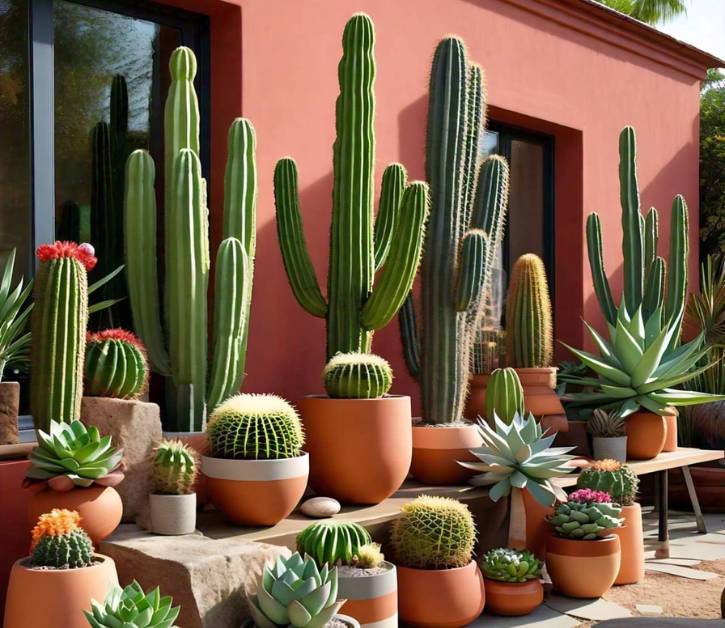
3. Terrariums and Mini Gardens
If you like making one-of-a-kind displays, you could make a miniature cactus garden in a terrarium or small pot. To make a desert-themed scene, use pebbles, decorative stones, or small figurines. Make sure the cacti you choose are small enough to do well in a small area, and make sure the pot has good drainage.
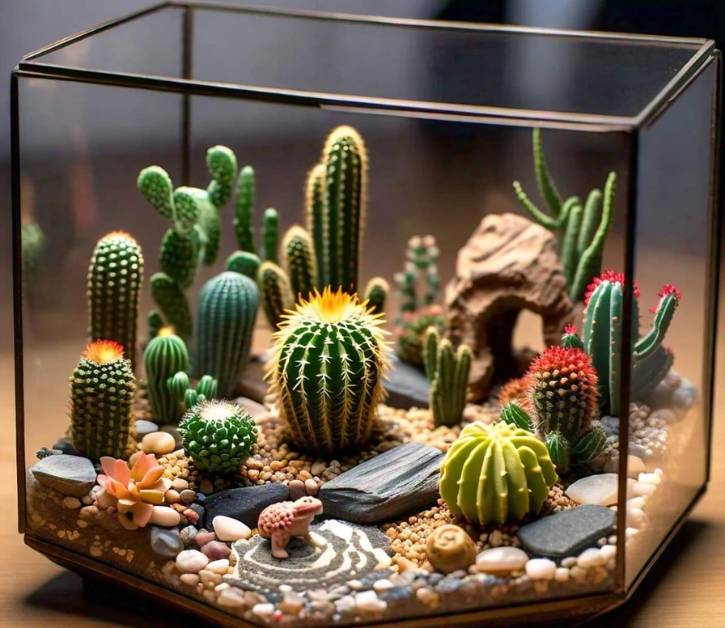
Conclusion
Add some greenery to your home or garden with cactus in flower pots. It’s easy to care for and looks great. They look great, can be grown in a variety of situations, and don’t need much care, so they’re great for both new and experienced plant lovers. Potted cacti are a stylish and useful choice whether you want a small plant for your desk, a big piece for your living room, or a big show outside.
Not only are cacti beautiful to look at, but they are also very hardy and don’t need much care over time. Because they can grow in a variety of indoor and outdoor conditions and have beautiful shapes and textures, they are often used as house decor. As you add these one-of-a-kind plants to your place, you’ll find that taking care of them is easy and fun. You can enjoy the beauty of nature with little work if you grow cactus in flower pot, even if you have never taken care of plants before.
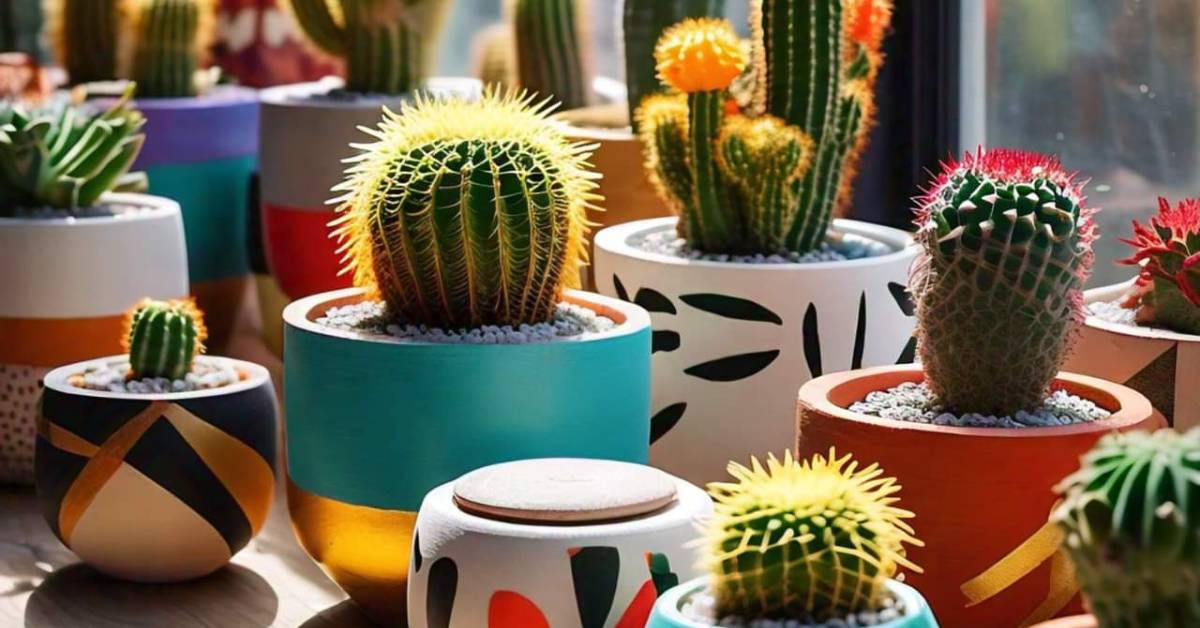



Pingback: Growing Florida Cranberry Hibiscus: A Complete Guide
Your article helped me a lot, is there any more related content? Thanks!
Welcome. What type of information related this contents you need. tell me I try to add more article about your topic.